Nathaniel Hawthorne
Nathaniel Hawthorne (/ˈhɔːθɔːrn/; né Hathorne; July 4, 1804 – May 19, 1864) was an American novelist, dark romantic, and short story writer. His works often focus on history, morality, and religion.
Nathaniel Hawthorne | |
|---|---|
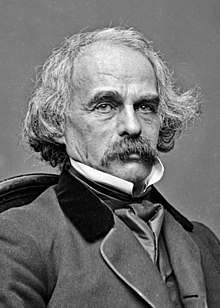 Hawthorne in the 1860s | |
| Born | Nathaniel Hathorne July 4, 1804 Salem, Massachusetts, US |
| Died | May 19, 1864 (aged 59) Plymouth, New Hampshire, US |
| Language | English |
| Alma mater | Bowdoin College |
| Notable works |
|
| Spouse | |
| Children |
|
| Signature | |
He was born in 1804 in Salem, Massachusetts, to Nathaniel Hathorne and the former Elizabeth Clarke Manning. His ancestors include John Hathorne, the only judge from the Salem witch trials who never repented his involvement. He entered Bowdoin College in 1821, was elected to Phi Beta Kappa in 1824,[1] and graduated in 1825. He published his first work in 1828, the novel Fanshawe; he later tried to suppress it, feeling that it was not equal to the standard of his later work.[2] He published several short stories in periodicals, which he collected in 1837 as Twice-Told Tales. The next year, he became engaged to Sophia Peabody. He worked at the Boston Custom House and joined Brook Farm, a transcendentalist community, before marrying Peabody in 1842. The couple moved to The Old Manse in Concord, Massachusetts, later moving to Salem, the Berkshires, then to The Wayside in Concord. The Scarlet Letter was published in 1850, followed by a succession of other novels. A political appointment as consul took Hawthorne and family to Europe before their return to Concord in 1860. Hawthorne died on May 19, 1864, and was survived by his wife and their three children.
Much of Hawthorne's writing centers on New England, many works featuring moral metaphors with an anti-Puritan inspiration. His fiction works are considered part of the Romantic movement and, more specifically, dark romanticism. His themes often center on the inherent evil and sin of humanity, and his works often have moral messages and deep psychological complexity. His published works include novels, short stories, and a biography of his college friend Franklin Pierce, the 14th President of the United States.
Biography
Early life
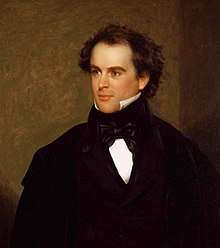
Nathaniel Hawthorne was born on July 4, 1804, in Salem, Massachusetts; his birthplace is preserved and open to the public.[3] William Hathorne was the author's great-great-great-grandfather. He was a Puritan and was the first of the family to emigrate from England, settling in Dorchester, Massachusetts, before moving to Salem. There he became an important member of the Massachusetts Bay Colony and held many political positions, including magistrate and judge, becoming infamous for his harsh sentencing.[4] William's son and the author's great-great-grandfather John Hathorne was one of the judges who oversaw the Salem witch trials. Hawthorne probably added the "w" to his surname in his early twenties, shortly after graduating from college, in an effort to dissociate himself from his notorious forebears.[5] Hawthorne's father Nathaniel Hathorne Sr. was a sea captain who died in 1808 of yellow fever in Dutch Suriname;[6] he had been a member of the East India Marine Society.[7] After his death, his widow moved with young Nathaniel and two daughters to live with relatives named the Mannings in Salem,[8] where they lived for 10 years. Young Hawthorne was hit on the leg while playing "bat and ball" on November 10, 1813,[9] and he became lame and bedridden for a year, though several physicians could find nothing wrong with him.[10]
In the summer of 1816, the family lived as boarders with farmers[11] before moving to a home recently built specifically for them by Hawthorne's uncles Richard and Robert Manning in Raymond, Maine, near Sebago Lake.[12] Years later, Hawthorne looked back at his time in Maine fondly: "Those were delightful days, for that part of the country was wild then, with only scattered clearings, and nine tenths of it primeval woods."[13] In 1819, he was sent back to Salem for school and soon complained of homesickness and being too far from his mother and sisters.[14] He distributed seven issues of The Spectator to his family in August and September 1820 for the sake of having fun. The homemade newspaper was written by hand and included essays, poems, and news featuring the young author's adolescent humor.[15]
Hawthorne's uncle Robert Manning insisted that the boy attend college, despite Hawthorne's protests.[16] With the financial support of his uncle, Hawthorne was sent to Bowdoin College in 1821, partly because of family connections in the area, and also because of its relatively inexpensive tuition rate.[17] Hawthorne met future president Franklin Pierce on the way to Bowdoin, at the stage stop in Portland, and the two became fast friends.[16] Once at the school, he also met future poet Henry Wadsworth Longfellow, future congressman Jonathan Cilley, and future naval reformer Horatio Bridge.[18] He graduated with the class of 1825, and later described his college experience to Richard Henry Stoddard:
I was educated (as the phrase is) at Bowdoin College. I was an idle student, negligent of college rules and the Procrustean details of academic life, rather choosing to nurse my own fancies than to dig into Greek roots and be numbered among the learned Thebans.[19]
Early career
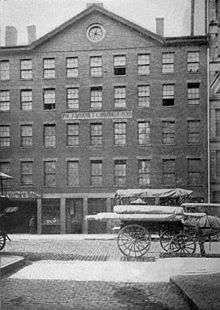
In 1836, Hawthorne served as the editor of the American Magazine of Useful and Entertaining Knowledge. At the time, he boarded with poet Thomas Green Fessenden on Hancock Street in Beacon Hill in Boston.[21] He was offered an appointment as weigher and gauger at the Boston Custom House at a salary of $1,500 a year, which he accepted on January 17, 1839.[22] During his time there, he rented a room from George Stillman Hillard, business partner of Charles Sumner.[23] Hawthorne wrote in the comparative obscurity of what he called his "owl's nest" in the family home. As he looked back on this period of his life, he wrote: "I have not lived, but only dreamed about living."[24] He contributed short stories to various magazines and annuals, including "Young Goodman Brown" and "The Minister's Black Veil", though none drew major attention to him. Horatio Bridge offered to cover the risk of collecting these stories in the spring of 1837 into the volume Twice-Told Tales, which made Hawthorne known locally.[25]
Marriage and family
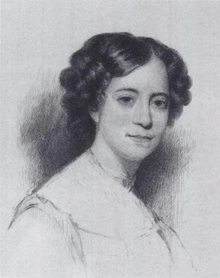
While at Bowdoin, Hawthorne wagered a bottle of Madeira wine with his friend Jonathan Cilley that Cilley would get married before Hawthorne did.[26] By 1836, he had won the bet, but he did not remain a bachelor for life. He had public flirtations with Mary Silsbee and Elizabeth Peabody,[27] then he began pursuing Peabody's sister, illustrator and transcendentalist Sophia Peabody. He joined the transcendentalist Utopian community at Brook Farm in 1841, not because he agreed with the experiment but because it helped him save money to marry Sophia.[28] He paid a $1,000 deposit and was put in charge of shoveling the hill of manure referred to as "the Gold Mine".[29] He left later that year, though his Brook Farm adventure became an inspiration for his novel The Blithedale Romance.[30] Hawthorne married Sophia Peabody on July 9, 1842, at a ceremony in the Peabody parlor on West Street in Boston.[31] The couple moved to The Old Manse in Concord, Massachusetts,[32] where they lived for three years. His neighbor Ralph Waldo Emerson invited him into his social circle, but Hawthorne was almost pathologically shy and stayed silent at gatherings.[33] At the Old Manse, Hawthorne wrote most of the tales collected in Mosses from an Old Manse.[34]
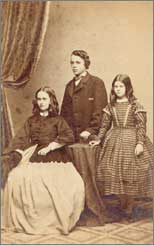
Like Hawthorne, Sophia was a reclusive person. Throughout her early life, she had frequent migraines and underwent several experimental medical treatments.[35] She was mostly bedridden until her sister introduced her to Hawthorne, after which her headaches seem to have abated. The Hawthornes enjoyed a long and happy marriage. He referred to her as his "Dove" and wrote that she "is, in the strictest sense, my sole companion; and I need no other—there is no vacancy in my mind, any more than in my heart ... Thank God that I suffice for her boundless heart!"[36] Sophia greatly admired her husband's work. She wrote in one of her journals:
I am always so dazzled and bewildered with the richness, the depth, the ... jewels of beauty in his productions that I am always looking forward to a second reading where I can ponder and muse and fully take in the miraculous wealth of thoughts.[37]
Poet Ellery Channing came to the Old Manse for help on the first anniversary of the Hawthornes' marriage. A local teenager named Martha Hunt had drowned herself in the river and Hawthorne's boat Pond Lily was needed to find her body. Hawthorne helped recover the corpse, which he described as "a spectacle of such perfect horror ... She was the very image of death-agony".[38] The incident later inspired a scene in his novel The Blithedale Romance.
The Hawthornes had three children. Their first was daughter Una, born March 3, 1844; her name was a reference to The Faerie Queene, to the displeasure of family members.[39] Hawthorne wrote to a friend, "I find it a very sober and serious kind of happiness that springs from the birth of a child ... There is no escaping it any longer. I have business on earth now, and must look about me for the means of doing it."[40] In October 1845, the Hawthornes moved to Salem.[41] In 1846, their son Julian was born. Hawthorne wrote to his sister Louisa on June 22, 1846: "A small troglodyte made his appearance here at ten minutes to six o'clock this morning, who claimed to be your nephew."[42] Daughter Rose was born in May 1851, and Hawthorne called her his "autumnal flower".[43]
Middle years
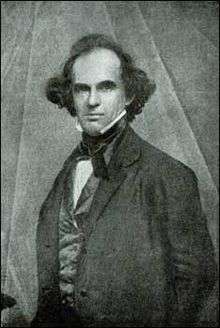
In April 1846, Hawthorne was officially appointed the Surveyor for the District of Salem and Beverly and Inspector of the Revenue for the Port of Salem at an annual salary of $1,200.[44] He had difficulty writing during this period, as he admitted to Longfellow:
I am trying to resume my pen ... Whenever I sit alone, or walk alone, I find myself dreaming about stories, as of old; but these forenoons in the Custom House undo all that the afternoons and evenings have done. I should be happier if I could write.[45]
This employment, like his earlier appointment to the custom house in Boston, was vulnerable to the politics of the spoils system. Hawthorne was a Democrat and lost this job due to the change of administration in Washington after the presidential election of 1848. He wrote a letter of protest to the Boston Daily Advertiser which was attacked by the Whigs and supported by the Democrats, making Hawthorne's dismissal a much-talked about event in New England.[46] He was deeply affected by the death of his mother in late July, calling it "the darkest hour I ever lived".[47] He was appointed the corresponding secretary of the Salem Lyceum in 1848. Guests who came to speak that season included Emerson, Thoreau, Louis Agassiz, and Theodore Parker.[48]
Hawthorne returned to writing and published The Scarlet Letter in mid-March 1850,[49] including a preface that refers to his three-year tenure in the Custom House and makes several allusions to local politicians—who did not appreciate their treatment.[50] It was one of the first mass-produced books in America, selling 2,500 volumes within ten days and earning Hawthorne $1,500 over 14 years.[51] The book was pirated by booksellers in London and became a best-seller in the United States;[52] it initiated his most lucrative period as a writer.[51] Hawthorne's friend Edwin Percy Whipple objected to the novel's "morbid intensity" and its dense psychological details, writing that the book "is therefore apt to become, like Hawthorne, too painfully anatomical in his exhibition of them",[53] though 20th-century writer D. H. Lawrence said that there could be no more perfect work of the American imagination than The Scarlet Letter.[54]
Hawthorne and his family moved to a small red farmhouse near Lenox, Massachusetts, at the end of March 1850.[55] He became friends with Herman Melville beginning on August 5, 1850, when the authors met at a picnic hosted by a mutual friend.[56] Melville had just read Hawthorne's short story collection Mosses from an Old Manse, and his unsigned review of the collection was printed in The Literary World on August 17 and August 24 titled "Hawthorne and His Mosses".[57] Melville wrote that these stories revealed a dark side to Hawthorne, "shrouded in blackness, ten times black".[58] He was composing his novel Moby-Dick at the time,[58] and dedicated the work in 1851 to Hawthorne: "In token of my admiration for his genius, this book is inscribed to Nathaniel Hawthorne."[59]
Hawthorne's time in the Berkshires was very productive.[60] While there, he wrote The House of the Seven Gables (1851), which poet and critic James Russell Lowell said was better than The Scarlet Letter and called "the most valuable contribution to New England history that has been made."[61] He also wrote The Blithedale Romance (1852), his only work written in the first person.[30] He also published A Wonder-Book for Girls and Boys in 1851, a collection of short stories retelling myths which he had been thinking about writing since 1846.[62] Nevertheless, poet Ellery Channing reported that Hawthorne "has suffered much living in this place".[63] The family enjoyed the scenery of the Berkshires, although Hawthorne did not enjoy the winters in their small house. They left on November 21, 1851.[60] Hawthorne noted, "I am sick to death of Berkshire ... I have felt languid and dispirited, during almost my whole residence."[64]
The Wayside and Europe
| External video | |
|---|---|
In May 1852, the Hawthornes returned to Concord where they lived until July 1853.[41] In February, they bought The Hillside, a home previously inhabited by Amos Bronson Alcott and his family, and renamed it The Wayside.[65] Their neighbors in Concord included Emerson and Henry David Thoreau.[66] That year, Hawthorne wrote The Life of Franklin Pierce, the campaign biography of his friend which depicted him as "a man of peaceful pursuits".[67] Horace Mann said, "If he makes out Pierce to be a great man or a brave man, it will be the greatest work of fiction he ever wrote."[67] In the biography, Hawthorne depicts Pierce as a statesman and soldier who had accomplished no great feats because of his need to make "little noise" and so "withdrew into the background".[68] He also left out Pierce's drinking habits, despite rumors of his alcoholism,[69] and emphasized Pierce's belief that slavery could not "be remedied by human contrivances" but would, over time, "vanish like a dream".[70]
With Pierce's election as President, Hawthorne was rewarded in 1853 with the position of United States consul in Liverpool shortly after the publication of Tanglewood Tales.[71] The role was considered the most lucrative foreign service position at the time, described by Hawthorne's wife as "second in dignity to the Embassy in London".[72] His appointment ended in 1857 at the close of the Pierce administration. The Hawthorne family toured France and Italy until 1860. During his time in Italy, the previously clean-shaven Hawthorne grew a bushy mustache.[73]
The family returned to The Wayside in 1860,[74] and that year saw the publication of The Marble Faun, his first new book in seven years.[75] Hawthorne admitted that he had aged considerably, referring to himself as "wrinkled with time and trouble".[76]
Later years and death
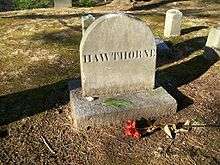
At the outset of the American Civil War, Hawthorne traveled with William D. Ticknor to Washington, D.C., where he met Abraham Lincoln and other notable figures. He wrote about his experiences in the essay "Chiefly About War Matters" in 1862.
Failing health prevented him from completing several more romance novels. Hawthorne was suffering from pain in his stomach and insisted on a recuperative trip with his friend Franklin Pierce, though his neighbor Bronson Alcott was concerned that Hawthorne was too ill.[77] While on a tour of the White Mountains, he died in his sleep on May 19, 1864, in Plymouth, New Hampshire. Pierce sent a telegram to Elizabeth Peabody asking her to inform Mrs. Hawthorne in person. Mrs. Hawthorne was too saddened by the news to handle the funeral arrangements herself.[78] Hawthorne's son Julian was a freshman at Harvard College, and he learned of his father's death the next day; coincidentally, he was initiated into the Delta Kappa Epsilon fraternity on the same day by being blindfolded and placed in a coffin.[79] Longfellow wrote a tribute poem to Hawthorne published in 1866 called "The Bells of Lynn".[80] Hawthorne was buried on what is now known as "Authors' Ridge" in Sleepy Hollow Cemetery, Concord, Massachusetts.[81] Pallbearers included Longfellow, Emerson, Alcott, Oliver Wendell Holmes Sr., James Thomas Fields, and Edwin Percy Whipple.[82] Emerson wrote of the funeral: "I thought there was a tragic element in the event, that might be more fully rendered—in the painful solitude of the man, which, I suppose, could no longer be endured, & he died of it."[83]
His wife Sophia and daughter Una were originally buried in England. However, in June 2006, they were reinterred in plots adjacent to Hawthorne.[84]
Writings
Hawthorne had a particularly close relationship with his publishers William Ticknor and James Thomas Fields.[85] Hawthorne once told Fields, "I care more for your good opinion than for that of a host of critics."[86] In fact, it was Fields who convinced Hawthorne to turn The Scarlet Letter into a novel rather than a short story.[87] Ticknor handled many of Hawthorne's personal matters, including the purchase of cigars, overseeing financial accounts, and even purchasing clothes.[88] Ticknor died with Hawthorne at his side in Philadelphia in 1864; according to a friend, Hawthorne was left "apparently dazed".[89]
Literary style and themes
Hawthorne's works belong to romanticism or, more specifically, dark romanticism,[90] cautionary tales that suggest that guilt, sin, and evil are the most inherent natural qualities of humanity.[91] Many of his works are inspired by Puritan New England,[92] combining historical romance loaded with symbolism and deep psychological themes, bordering on surrealism.[93] His depictions of the past are a version of historical fiction used only as a vehicle to express common themes of ancestral sin, guilt and retribution.[94] His later writings also reflect his negative view of the Transcendentalism movement.[95]
Hawthorne was predominantly a short story writer in his early career. Upon publishing Twice-Told Tales, however, he noted, "I do not think much of them," and he expected little response from the public.[96] His four major romances were written between 1850 and 1860: The Scarlet Letter (1850), The House of the Seven Gables (1851), The Blithedale Romance (1852) and The Marble Faun (1860). Another novel-length romance, Fanshawe, was published anonymously in 1828. Hawthorne defined a romance as being radically different from a novel by not being concerned with the possible or probable course of ordinary experience.[97] In the preface to The House of the Seven Gables, Hawthorne describes his romance-writing as using "atmospherical medium as to bring out or mellow the lights and deepen and enrich the shadows of the picture".[98] The picture, Daniel Hoffman found, was one of "the primitive energies of fecundity and creation."[99]
Critics have applied feminist perspectives and historicist approaches to Hawthorne's depictions of women. Feminist scholars are interested particularly in Hester Prynne: they recognize that while she herself could not be the "destined prophetess" of the future, the "angel and apostle of the coming revelation" must nevertheless "be a woman." [100] Camille Paglia saw Hester as mystical, "a wandering goddess still bearing the mark of her Asiatic origins ... moving serenely in the magic circle of her sexual nature".[101] Lauren Berlant termed Hester "the citizen as woman [personifying] love as a quality of the body that contains the purest light of nature," her resulting "traitorous political theory" a "Female Symbolic" literalization of futile Puritan metaphors.[102] Historicists view Hester as a protofeminist and avatar of the self-reliance and responsibility that led to women's suffrage and reproductive emancipation. Anthony Splendora found her literary genealogy among other archetypally fallen but redeemed women, both historic and mythic. As examples, he offers Psyche of ancient legend; Heloise of twelfth-century France's tragedy involving world-renowned philosopher Peter Abelard; Anne Hutchinson (America's first heretic, circa 1636), and Hawthorne family friend Margaret Fuller.[103] In Hester's first appearance, Hawthorne likens her, "infant at her bosom", to Mary, Mother of Jesus, "the image of Divine Maternity". In her study of Victorian literature, in which such "galvanic outcasts" as Hester feature prominently, Nina Auerbach went so far as to name Hester's fall and subsequent redemption, "the novel's one unequivocally religious activity".[104] Regarding Hester as a deity figure, Meredith A. Powers found in Hester's characterization "the earliest in American fiction that the archetypal Goddess appears quite graphically," like a Goddess "not the wife of traditional marriage, permanently subject to a male overlord"; Powers noted "her syncretism, her flexibility, her inherent ability to alter and so avoid the defeat of secondary status in a goal-oriented civilization".[105]
Aside from Hester Prynne, the model women of Hawthorne's other novels—from Ellen Langton of Fanshawe to Zenobia and Priscilla of The Blithedale Romance, Hilda and Miriam of The Marble Faun and Phoebe and Hepzibah of The House of the Seven Gables—are more fully realized than his male characters, who merely orbit them.[106] This observation is equally true of his short-stories, in which central females serve as allegorical figures: Rappaccini's beautiful but life-altering, garden-bound, daughter; almost-perfect Georgiana of "The Birthmark"; the sinned-against (abandoned) Ester of "Ethan Brand"; and goodwife Faith Brown, linchpin of Young Goodman Brown's very belief in God. "My Faith is gone!" Brown exclaims in despair upon seeing his wife at the Witches' Sabbath.. Perhaps the most sweeping statement of Hawthorne's impetus comes from Mark Van Doren: "Somewhere, if not in the New England of his time, Hawthorne unearthed the image of a goddess supreme in beauty and power."[107]
Hawthorne also wrote nonfiction. In 2008, the Library of America selected Hawthorne's "A show of wax-figures" for inclusion in its two-century retrospective of American True Crime.[108]
Criticism
In "Hawthorne and His Mosses", Herman Melville wrote a passionate argument for Hawthorne to be among the burgeoning American literary canon, "He is one of the new, and far better generation of your writers." In this review of Mosses from an Old Manse, Melville describes an affinity for Hawthorne that would only increase: "I feel that this Hawthorne has dropped germinous seeds into my soul. He expands and deepens down, the more I contemplate him; and further, and further, shoots his strong New-England roots into the hot soil of my Southern soul." Edgar Allan Poe wrote important reviews of both Twice-Told Tales and Mosses from an Old Manse. Poe's assessment was partly informed by his contempt of allegory and moral tales, and his chronic accusations of plagiarism, though he admitted,
The style of Mr. Hawthorne is purity itself. His tone is singularly effective—wild, plaintive, thoughtful, and in full accordance with his themes ... We look upon him as one of the few men of indisputable genius to whom our country has as yet given birth.[109]
John Neal's magazine The Yankee published the first substantial public praise of Hawthorne, saying in 1828 that the author of Fanshawe has a "fair prospect of future success."[110] Ralph Waldo Emerson wrote, "Nathaniel Hawthorne's reputation as a writer is a very pleasing fact, because his writing is not good for anything, and this is a tribute to the man."[111] Henry James praised Hawthorne, saying, "The fine thing in Hawthorne is that he cared for the deeper psychology, and that, in his way, he tried to become familiar with it."[112] Poet John Greenleaf Whittier wrote that he admired the "weird and subtle beauty" in Hawthorne's tales.[113] Evert Augustus Duyckinck said of Hawthorne, "Of the American writers destined to live, he is the most original, the one least indebted to foreign models or literary precedents of any kind."[114]
Contemporary response to Hawthorne's work praised his sentimentality and moral purity while more modern evaluations focus on the dark psychological complexity.[115] Beginning in the 1950s, critics have focused on symbolism and didacticism.[116]
The critic Harold Bloom opined that only Henry James and William Faulkner challenge Hawthorne's position as the greatest American novelist, although he admitted that he favored James as the greatest American novelist.[117][118] Bloom saw Hawthorne's greatest works to be principally The Scarlet Letter, followed by The Marble Faun and certain short stories, including "My Kinsman, Major Molineux", "Young Goodman Brown", "Wakefield", and "Feathertop".[118]
Selected works
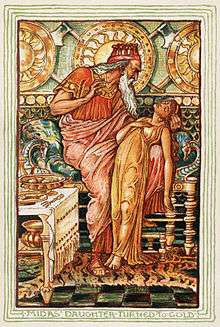
The "definitive edition" of Hawthorne's works[119] is The Centenary Edition of the Works of Nathaniel Hawthorne, edited by William Charvat and others, published by The Ohio State University Press in twenty-three volumes between 1962 and 1997.[120] Tales and Sketches (1982) was the second volume to be published in the Library of America, Collected Novels (1983) the tenth.[121]
Novels
- Fanshawe (published anonymously, 1828)[122]
- The Scarlet Letter, A Romance (1850)
- The House of the Seven Gables, A Romance (1851)
- The Blithedale Romance (1852)
- The Marble Faun: Or, The Romance of Monte Beni (1860) (as Transformation: Or, The Romance of Monte Beni, UK publication, same year)
- The Dolliver Romance (1863) (unfinished)
- Septimius Felton; or, the Elixir of Life (unfinished, published in the Atlantic Monthly, 1872)
- Doctor Grimshawe's Secret: A Romance (unfinished, with preface and notes by Julian Hawthorne, 1882)
Short story collections
- Twice-Told Tales (1837)
- Grandfather's Chair (1840)
- Mosses from an Old Manse (1846)
- A Wonder-Book for Girls and Boys (1851)
- The Snow-Image, and Other Twice-Told Tales (1852)
- Tanglewood Tales (1853)
- The Dolliver Romance and Other Pieces (1876)
- The Great Stone Face and Other Tales of the White Mountains (1889)
Selected short stories
- "The Hollow of the Three Hills" (1830)
- "Roger Malvin's Burial" (1832)
- "My Kinsman, Major Molineux" (1832)
- "The Minister's Black Veil" (1832)
- "Young Goodman Brown" (1835)
- "The Gray Champion" (1835)
- "The White Old Maid" (1835)
- "Wakefield" (1835)
- "The Ambitious Guest" (1835)
- "The Man of Adamant" (1837)
- "The May-Pole of Merry Mount" (1837)
- "The Great Carbuncle" (1837)
- "Dr. Heidegger's Experiment" (1837)
- "A Virtuoso's Collection" (May 1842)
- "The Birth-Mark" (March 1843)
- "The Celestial Railroad" (1843)
- "Egotism; or, The Bosom-Serpent" (1843)
- "Earth's Holocaust" (1844)
- "Rappaccini's Daughter" (1844)
- "P.'s Correspondence" (1845)
- "The Artist of the Beautiful" (1846)
- "Fire Worship" (1846)
- "Ethan Brand" (1850)
- "The Great Stone Face" (1850)
- "Feathertop" (1852)
Nonfiction
- Twenty Days with Julian & Little Bunny (written 1851, published 1904)
- Our Old Home (1863)
- Passages from the French and Italian Notebooks (1871)
See also
References
Notes
- Who Belongs To Phi Beta Kappa Archived January 3, 2012, at the Wayback Machine, Phi Beta Kappa website, accessed Oct 4, 2009
- Hawthorne, Nathaniel (1828). Fanshawe. Boston: Marsh & Capen.
- Haas, Irvin. Historic Homes of American Authors. Washington, DC: The Preservation Press, 1991: 118. ISBN 0-89133-180-8.
- Miller, 20–21
- McFarland, 18
- Wineapple, 20–21
- Edward B. Hungerford (1933). "Hawthorne Gossips about Salem". New England Quarterly. 6 (3): 445–469. doi:10.2307/359552. JSTOR 359552.
- McFarland, 17
- Miller, 47
- Mellow, 18
- Mellow, 20
- Miller, 50
- Mellow, 21
- Mellow, 22
- Miller, 57
- Edwards, Herbert. "Nathaniel Hawthorne in Maine", Downeast Magazine, 1962
- Wineapple, 44–45
- Cheever, 99
- Miller, 76
- George Edwin Jepson. "Hawthorne in the Boston Custom House". The Bookman. August 1904.
- Wineapple, 87–88
- Miller, 169
- Mellow, 169
- Letter to Longfellow, June 4, 1837.
- McFarland, 22–23
- Manning Hawthorne, "Nathaniel Hawthorne at Bowdoin", The New England Quarterly, Vol. 13, No. 2 (June 1940): 246–279.
- Cheever, 102
- McFarland, 83
- Cheever, 104
- McFarland, 149
- Wineapple, 160
- McFarland, 25
- Schreiner, 123
- Miller, 246–247
- Mellow, 6–7
- McFarland, 87
- January 14, 1851, Journal of Sophia Hawthorne. Berg Collection NY Public Library.
- Schreiner, 116–117
- McFarland, 97
- Schreiner, 119
- Reynolds, 10
- Mellow, 273
- Miller, 343–344
- Miller, 242
- Miller, 265
- Cheever, 179
- Cheever, 180
- Miller, 264–265
- Miller, 300
- Mellow, 316
- McFarland, 136
- Cheever, 181
- Miller, 301–302
- Miller, 284
- Miller, 274
- Cheever, 96
- Miller, 312
- Mellow, 335
- Mellow, 382
- Wright, John Hardy. Hawthorne's Haunts in New England. Charleston, SC: The History Press, 2008: 93. ISBN 978-1-59629-425-7
- Mellow, 368–369
- Miller, 345
- Wineapple, 241
- Wineapple, 242
- McFarland, 129–130
- McFarland, 182
- Miller, 381
- Schreiner, 170–171
- Mellow, 412
- Miller, 382–383
- McFarland, 186
- Mellow, 415
- McFarland, 210
- McFarland, 206
- Mellow, 520
- Schreiner, 207
- Wineapple, 372
- Miller, 518
- Matthews, Jack (August 15, 2010). "Nathaniel Hawthorne's Untold Tale". The Chronicle Review. Retrieved August 17, 2010.
- Wagenknecht, Edward. Henry Wadsworth Longfellow: Portrait of an American Humanist. New York: Oxford University Press, 1966: 9.
- Wilson, Scott. Resting Places: The Burial Sites of More Than 14,000 Famous Persons, 3d ed.: 2 (Kindle Locations 20433-20434). McFarland & Company, Inc., Publishers. Kindle Edition.
- Baker, Carlos. Emerson Among the Eccentrics: A Group Portrait. New York: Viking Press, 1996: 448. ISBN 0-670-86675-X.
- McFarland, 297
- Mishra, Raja and Sally Heaney. "Hawthornes to be reunited", The Boston Globe. June 1, 2006. Accessed July 4, 2008
- Madison, 9
- Miller, 281
- Charvat, William. Literary Publishing in America: 1790–1850. Amherst, MA: The University of Massachusetts Press, 1993 (first published 1959): 56. ISBN 0-87023-801-9
- Madison, 15
- Miller, 513–514
- Reynolds, David S. Beneath the American Renaissance: The Subversive Imagination in the Age of Emerson and Melville. Cambridge, Massachusetts: Harvard University Press, 1988: 524. ISBN 0-674-06565-4
- Wayne, Tiffany K. "Nathaniel Hawthorne", Encyclopedia of Transcendentalism. New York: Facts on File, Inc., 2006: 140. ISBN 0-8160-5626-9.
- Bell, Michael Davitt. Hawthorne and the Historical Romance of New England. Boston: Houghton Mifflin Company, 1980: 173. ISBN 0-691-06136-X
- Howe, Daniel Walker. What Hath God Wrought: The Transformation of America, 1815–1848. New York: Oxford University Press, 2007: 633. ISBN 978-0-19-507894-7.
- Crews, 28–29
- Galens, David, ed. Literary Movements for Students, Vol. 1. Detroit: Thompson Gale, 2002: 319. ISBN 0-7876-6517-7
- Miller, 104
- Porte, 95
- Wineapple, 237
- Hoffman, 356
- The Scarlet Letter Ch XXIV "Conclusion"
- Paglia, Sexual Personae, 581, 583
- Berlant, The Anatomy of National Fantasy, 94, 148, 175
- Splendora, "Psyche and Hester", 2, 5, 18
- Auerbach, Woman and the Demon, 150, 166
- Powers, The Heroine in Western Literature, 144
- Splendora, "Psyche and Hester", 12
- Van Doren 19
- True Crime: An American Anthology, Library of America website, accessed Jan 30, 2018
- McFarland, 88–89
- Lease, Benjamin (1972). That Wild Fellow John Neal and the American Literary Revolution. Chicago, Illinois: University of Chicago Press. pp. 129, 133. ISBN 0-226-46969-7.
- Nelson, Randy F. (editor). The Almanac of American Letters. Los Altos, California: William Kaufmann, Inc., 1981: 150. ISBN 0-86576-008-X.
- Porte, 97
- Woodwell, Roland H. John Greenleaf Whittier: A Biography. Haverhill, Massachusetts: Trustees of the John Greenleaf Whittier Homestead, 1985: 293.
- McFarland, 88
- Person, Leland S. "Bibliographical Essay: Hawthorne and History", collected in A Historical Guide to Nathaniel Hawthorne. Oxford University Press, 2001: 187. ISBN 0-19-512414-6.
- Crews, 4
- Nathaniel Hawthorne by Harold Bloom (2000) p. 9
- Nathaniel Hawthorne by Harold Bloom p. xii
- Rita K. Gollin, Hawthorne, Nathaniel, American National Biography Online Feb. 2000
- Hawthorne, Nathaniel (1962). The Centenary Edition of the Works of Nathaniel Hawthorne. Columbus: Ohio State University Press. ISBN 9780814200599. OCLC 274693.
- Library of America Series
- Publication info on books from Editor's Note to The Scarlet Letter by Nathaniel Hawthorne, Page by Page Books, accessed June 11, 2007.
Sources
- Auerbach, Nina, Woman and the Demon: The Life of a Victorian Myth (Cambridge, Massachusetts: Harvard University Press 1982)
- Berlant, Lauren. The Anatomy of National Fantasy: Hawthorne, Utopia, and Everyday Life (Chicago and London: University of Chicago Press 1991)
- Cheever, Susan. American Bloomsbury: Louisa May Alcott, Ralph Waldo Emerson, Margaret Fuller, Nathaniel Hawthorne, and Henry David Thoreau; Their Lives, Their Loves, Their Work. Detroit: Thorndike Press, 2006. Large print edition. ISBN 0-7862-9521-X.
- Crews, Frederick. The Sins of the Fathers: Hawthorne's Psychological Themes. Berkeley: University of California Press, 1966; reprinted 1989. ISBN 0-520-06817-3.
- Hoffman, Daniel G. Form and Fable in American Fiction. University of Virginia Press 1994.
- Madison, Charles A. Irving to Irving: Author-Publisher Relations 1800–1974. New York: R. R. Bowker Company, 1974.
- McFarland, Philip. Hawthorne in Concord. New York: Grove Press, 2004. ISBN 0-8021-1776-7.
- Mellow, James R. Nathaniel Hawthorne in His Times. Boston: Houghton Mifflin Company, 1980. ISBN 0-395-27602-0.
- Miller, Edwin Haviland. Salem Is My Dwelling Place: A Life of Nathaniel Hawthorne. Iowa City: University of Iowa Press, 1991. ISBN 0-87745-332-2.
- Paglia, Camille. Sexual Personae: Art and Decadence from Nefertiti to Emily Dickinson (New York: Vintage 1991)
- Porte, Joel. The Romance in America: Studies in Cooper, Poe, Hawthorne, Melville, and James. Middletown, Conn.: Wesleyan University Press, 1969.
- Powers, Meredith A. The Heroine in Western Literature: The Archetype and Her Reemergence in Modern Prose (Jefferson, North Carolina and London: McFarland 1991)
- Reynolds, Larry J. "Hawthorne's Labors in Concord". The Cambridge Companion to Nathaniel Hawthorne. Edited by Richard H. Millington. Cambridge, UK, New York, US, and Melbourne, Australia: Cambridge University Press, 2004. ISBN 052180745X
- Schreiner, Samuel A., Jr. The Concord Quartet: Alcott, Emerson, Hawthorne, Thoreau, and the Friendship that Freed the American Mind. Hoboken, NJ: John Wiley and Sons, 2006. ISBN 0-471-64663-6.
- Splendora, Anthony. "Psyche and Hester, or Apotheosis and Epitome: Natural Grace, La Sagesse Naturale", The Rupkatha Journal of Interdisciplinary Studies in the Humanities, Vol. 5, No. 3 (2014), pp. 1–34 http://rupkatha.com/v5n3.php.
- Van Doren, Mark. Nathaniel Hawthorne: A Critical Biography. 1949; New York: Vintage 1957.
- Wineapple, Brenda. Hawthorne: A Life. Random House: New York, 2003. ISBN 0-8129-7291-0.
Further reading
- Bell, Michael Davitt. Hawthorne and the Historical Romance of New England (Princeton University Press, 2015).
- Forster, Sophia. "Elizabeth Stuart Phelps, Nathaniel Hawthorne, and the Emergence of American Literary Realism." Studies in the Novel 48.1 (2016): 43–64. online
- Greven, David. Gender Protest and Same-Sex Desire in Antebellum American Literature: Margaret Fuller, Edgar Allan Poe, Nathaniel Hawthorne, and Herman Melville (2015).
- Hallock, Thomas. "'A'is for Acronym: Teaching Hawthorne in a Performance-Based World." ESQ: A Journal of Nineteenth-Century American Literature and Culture 62#1 (2016): 116–121.
External links
| Wikimedia Commons has media related to Nathaniel Hawthorne. |
| Wikiquote has quotations related to: Nathaniel Hawthorne |
| Wikisource has original works written by or about: Nathaniel Hawthorne |
- About Hawthorne
- The Hawthorne in Salem website
- C. E. Frazer Clark collection of Nathaniel Hawthorne at the University of South Carolina Irvin Department of Rare Books and Special Collections.
- Herman Melville's appreciation, "Hawthorne and His Mosses" (1851)
- Henry James's book-length study, Hawthorne (1879)
- Hawthorne Family Papers, ca. 1825–1929, housed in the Department of Special Collections at Stanford University Libraries
- "Writings of Nathaniel Hawthorne" from C-SPAN's American Writers: A Journey Through History
- Hawthorne: Science, Progress, and Human Nature, series of essays on Hawthorne stories at The New Atlantis.
- Passages from the American Note-Books, by Nathaniel Hawthorne, edited by Sophia Hawthorne, 1868, Boston: Houghton, Mifflin, 1883 (volume IX of the 13-volume Riverside Edition of the Complete Works of Nathaniel Hawthorne).
- Joint diary of Sophia and Nathaniel Hawthorne at The Morgan Library & Museum
- Related websites
- Hawthorne Community Association and boyhood home in Raymond, Maine
- The Wayside in Concord, Massachusetts
- The House of the Seven Gables in Salem, Massachusetts
- The Phillips Library of The Peabody Essex Museum in Salem, Massachusetts owns several well-known Hawthorne related manuscript collections.
- Works
- Works by Nathaniel Hawthorne at Project Gutenberg
- Works by Nathaniel Hawthorne at Faded Page (Canada)
- Works by or about Nathaniel Hawthorne at Internet Archive
- Works by Nathaniel Hawthorne at LibriVox (public domain audiobooks)

- Legends of the Province House and Other Twice Told Tales, text and images